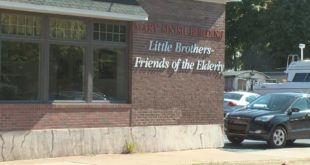Michigan Tech professor Mark Rudnicki wants to put Michigan hardwoods to use in a new and exciting way. Cross laminated timber technology is already a part of skyscrapers in Europe and America’s west coast. By pressing cross sections of wood together it is possible to create structural components as sturdy as the steel girders that make up landmarks like the Empire State Building or Detroit’s Renaissance Center.
Working with the MTEC Smart Zone, Rudnicki leveraged academic grants and corporate support to obtain a press that will assemble CLT right here in the Keweenaw. It’s for research purposes only, but the findings could help make the case for future commercial production. Rudnicki says new markets vital for an industry where traditional pulp isn’t in demand the way it once was.
United States Senator Debbie Stabenow visited Tech’s campus last year in support of the program and it has caught the eye of politicians in Lansing as well. Rudnicki says using wood in construction of megastructures helps to give the buildings character, a certain aesthetic that you don’t find currently. It’s also more environmentally friendly.
Rudnicki will be a guest on Copper Country Today this weekend.
———————————————————
With the recent closure of nearby pulp and paper mills in northern Wisconsin, prices for pulp logs have dropped in the Upper Peninsula of Michigan, leaving forest property holders with a depressed market for logs and in some cases with no market. In addition, loggers, truckers, and associated support industries are stressed to stay in business. There is a strong need for near-term expansion and diversification in hardwood product markets.
Mass timber has the potential to supply a significant market for lower-value hardwood pulp logs and bolts. Currently entirely made from softwood, mass timber consists of lumber glued together to form large structural elements for the construction of mid-rise and even high-rise buildings. This technology represents a revolution in the construction sector as wood buildings are carbon negative instead of a large source of carbon using the traditional materials of concrete and steel. The most common panel form of mass timber is Cross Laminated Timber (CLT).
“Manufacturing capacity of CLT in the US is currently 1/10th of the demand expected within 10 years,” says Mark Rudnicki, professor of practice in forest biomaterials at Michigan Technological University. “CLT is, therefore, a prime opportunity for increasing the economic resilience of our rural communities”.
Currently, commercial CLT products for tall timber buildings are made from only softwood species, despite hardwood’s many desirable properties such as increased strength, higher fire resistance, better resistance to vibration, better sound insulation, and aesthetic appeal. “Recent research at Michigan Tech has demonstrated that several hardwood species from the Great Lakes region, including our most common, sugar maple, can work well as a CLT product,” says Mark.
Support is needed for a new press designed for fabricating CLT panels to establish design properties and capabilities for Michigan hardwoods. This would be vital for inclusion in the standards that govern mass timber construction and would be of immediate practical use for engineers and architects to begin designing tall buildings with Michigan hardwoods.
Matching funds totaling $67,000 were required and obtained through various stakeholders. They include JM Longyear (Marquette, MI), Besse Forest Products Group (Gladstone, MI), AJD Forest Products (Grayling, MI), as well as both MTEC SmartZone and Innovate Marquette SmartZone. Both SmartZones are a part of the MEDC funded network of twenty SmartZones throughout the State of Michigan.
“Through this effort, a near-term impact will be the inclusion of common Michigan hardwood species into the CLT standard, and the long-term impact may be the establishment of a CLT manufacturing facility” added Mark. “We hope to have a number of grant applications submitted by MTU in the months and years after equipment acquisition and the establishment of collaborations with the private sector to develop specific CLT products using Michigan wood”.
 Keweenaw Report Your Source for Local News and Sports
Keweenaw Report Your Source for Local News and Sports






